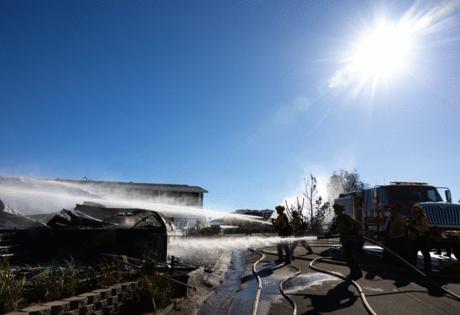As dry conditions persist, officials warn the San Diego area could be 'ready to burn'
Published in News & Features
SAN DIEGO — Heading into the final months of this year, residents in the San Diego area should prepare for a potentially combustible peak wildfire season.
“The outlook is not good,” Cal Fire/San Diego County Fire Chief Tony Mecham said Wednesday, citing a lack of rain in recent months that has left vegetation parched. “The fuels are receptive, they’re ready to burn, and then it’s really a matter of what happens with the weather … We could have major fires this year.”
Three months ago, San Diego Gas & Electric meteorologist and vice president of wildfire and climate science Brian D’Agostino said the San Diego area had only about 50% of normal rainfall and expected above-normal potential for fire ignitions.
At a news conference Wednesday with fire and emergency officials at SDG&E’s Wildfire and Climate Resilience Center, D’Agostino said conditions have not improved much since then.
“We’re always prepared, but we are especially prepared this year, just because we’re tending toward that dry potential,” D’Agostino said.
Just last week, the Coches fire in Lakeside scorched more than 5 acres, forced evacuations and destroyed six homes.
Thus far this year, Cal Fire has battled 220 brush fires in San Diego County. Nineteen were 10 acres or larger.
Mecham said Cal Fire’s Predictive Services Unit “is estimating an above-average fire danger as we move through the holiday season.”
Fire officials say one of the most important things homeowners should do is create defensible space around their houses. A buffer of about 100 feet between the structure and the grass, trees and shrubs can protect homes from catching fire from flames, embers and even radiant heat.
“Studies have shown 80% of homes lost to wildfire could have been saved with the right home hardening,” said San Diego Fire-Rescue Chief Robert Logan.
Mecham advises removing anything flammable that is within 5 feet of homes. “That’s wicker furniture, that’s trash cans, your wood piles, even ornamental plants and wood chips,” he said.
To reduce the risk of wildfires, investor-owned utilities in California deploy Public Safety Power Shutoffs to de-energize circuits in targeted areas when high winds and dry conditions elevate the risk of power lines falling and potentially igniting a wildfire. In San Diego County, they most commonly affect backcountry and rural communities such as Alpine, Julian, Fallbrook and Valley Center.
SDG&E implemented two such shutoffs back in January when an unprecedented succession of Santa Ana winds blew through the county for nearly three weeks. Areas such as Sill Hill in the Cuyamaca Mountains reported gusts surpassing 100 mph, but the county escaped any wildfire ignitions.
The Los Angeles area was not so fortunate, as the combination of hurricane-force winds, low humidity and drought conditions led to blazes in Pacific Palisades, Altadena and other spots.
A series of 14 wildfires ripped through the region between Jan. 7 and Jan. 31, destroying more than 18,000 homes and structures.
“Wildfire conditions are changing,” D’Agostino said. “We are seeing more extreme conditions across our region. It is time for us to adapt and be prepared for those changes.”
SDG&E’s weather network monitors more than 130 cameras that stream views of high-fire risk areas. The system includes 225 stations that measure wind speed, temperatures and humidity every 10 minutes. To bolster safety, the meteorology team integrates data from multiple sources, including the National Weather Service, with artificial intelligence.
Since wildfires in 2007 ravaged large swaths of San Diego County, SDG&E has spent roughly $6 billion to reduce the risk of widespread fires.
That includes building the Wildfire and Climate Resilience Center, creating what’s considered a state-of-the-art network, placing 325.4 miles of power lines underground since 2020 and replacing wooden power poles with fire-resistant steel poles.
The costs of those wildfire prevention programs are passed on to SDG&E ratepayers.
©2025 The San Diego Union-Tribune. Visit sandiegouniontribune.com. Distributed by Tribune Content Agency, LLC.







Comments